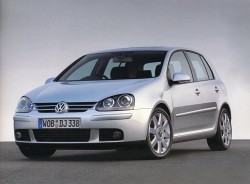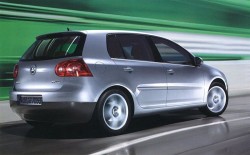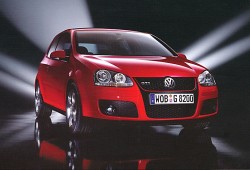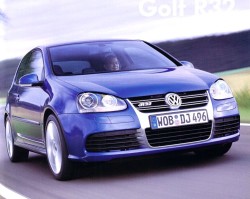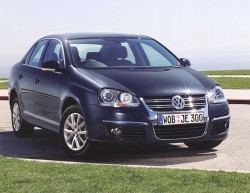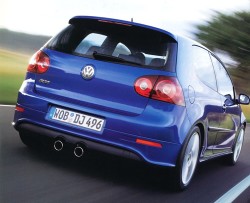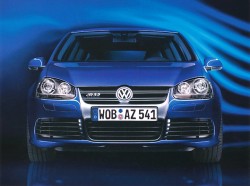Golf 5 and Jetta
Latest Golfs for Australia
Golf 5 – First Impressions
147 kW Golf 5 GTI
First drive – Golf 5 R32
The new Jetta
Golf quicker than ever at 30
Golf 5 R32
Latest Golfs for Australia
By Steve Carter
August 2003
The new Volkswagen Golf 5 popped its face into the limelight prior to its September launch, just as the local VW arm announces it is firing up the existing range.
Shots of the fifth-generation Golf have been released before its unveiling at the Frankfurt Motor Show in September. We'll see it here late next year.
To be sold in two and four-door variants, the Golf features a new twin-headlight design which brings it into line with the family look. Initial information suggests features that include six airbags and a safer steering column and pedal assembly. We'll get two direct-injection petrol engines at launch -a 85 kW 1.6 and 100 kW 2.0 litre.
Meanwhile. Volkswagen Australia is upping the ante in the hot hatch stakes with the most powerful Golf of all time. Expected here early next year, will be 200 of the R32 Golfs, with a $63,000 price tag.
It seems an automatic won't be on the features list - the R32 will come only in six-speed manual. Sitting on 18-inch alloy wheels, the R32 gets upgraded brakes and suspension tweaks to wet the appetite of hot-hatch fans.
The familiar 3.2-litre 15-degree DOHC 24-valve V6 puts 177 kW at 6250 rpm and 320 Nm between 2800 and 3200 rpm through all four wheels, for a claimed sprint to 100 km in 6.6 seconds and a 247 km/h top speed.
Apart from the performance upgrades, the Golf, in silver, blue or black, also gets a sports body kit, xenon headlights, honeycomb front grille and some new interior features, including leather trimmed sports front seats, a leather-trimmed steering wheel and gear shifter, alloy pedals and standard front, side and curtain air bags.
The 15-spoke 18-inch alloy wheels are designed to provide cooling for the bigger brakes - the front discs are 334 mm in diameter while the rears are 256 mm with inclusion of ABS.
The muscular look is taken even further by the reduced ride height, two large chrome tipped exhaust pipes (not there just for looks either, says VW) and an integrated aerodynamic spoiler atop the rear.
Golf 5 - First Impressions
By Jamie Vondruska
January 2004
It doesn't seem that long ago that Volkswagen introduced the fourth generation Golf, but the reality is six years have passed us by since it was first shown in Frankfurt of 1998. Back then it was lauded for its fit and finish, detailing, materials and standard features - it brought luxury features down into the compact class and forever changed the expectations of consumers as a result.
Now Volkswagen has launched the fifth generation A-platform (A5) Golf. Like the Golf 4 before it, the new Golf 5 has moved forward - or laterally anyway - with the progression of the now familiar Golf shape. As happened when the Golf 4 was first introduced, initial opinions are split on the overall look of the new Golf 5. Change never comes easy to VW enthusiasts and while some really like the new design, others aren't so enthusiastic about it. We should point out that most enthusiasts in North America or Australia have not seen the new Golf 5 in person yet, relying instead on photos which don't always convey what the car really looks like in the metal - so the final verdict for most will have to wait.
We recently had a chance to drive a German-market Golf 5 four-door in Highline (think GLS) trim level equipped with a 1.9-litre 75 kW TDI with Volkswagen's new DSG transmission. Simply opening a door gives the immediate impression that this new Golf is yet another level above the outgoing model. It feels considerably bigger on the inside with plenty of room for my six-foot frame to fit in the rear seats with another six-footer in front - in fact my knees don't even touch the front seats. Overall the interior has an even more upscale feel than the outgoing Golf 4, with loads of detailing. Materials inside are a mix of good and better with a few things feeling a little cheaper than the Golf 4. The leathers on the seats are a huge improvement with a beautiful nap and softness, but the rings around the HVAC controls are loose and a little ‘cheap’ feeling, for instance. The new HVAC controls are easy to adjust though and work perfectly, with dual-zone Climatronic giving the driver and passenger their own separate temperature controls. In the end the new Golf 5 imparts a strong sense of fine detailing and is still ahead of its competitors in the ‘dash-stroking’ game and should make any current VW owner more than happy with their surroundings.
As far as we're concerned, Volkswagen can skimp a little on the interior though for the chassis is an unbelievable improvement. As soon as you pull away and drive down the street you notice a huge difference. First the Golf 5 is unbelievably tight and rigid. The car is eerily quiet on the Autobahn with virtually no wind noise, plus the structure is amazingly stiff and solid - Volkswagen claims chassis rigidity is up 80% over the outgoing model, which was no slouch to start with. The car feels ‘German’ - little to no dive and squat and roll is very controlled, especially compared to the Golf 4. The ride is firm, but not harsh and is very compliant over bumps and dips. The first off-ramp we attacked would have had any current Golf 4 owner diving for something to grab on to, yet the Golf 5 had us smiling as it simply turned-in with no fuss, very little roll and with nice feedback through the steering wheel - no theatrics and very controlled. The new revised front strut and all-new four-link fully independent rear suspension are to be credited for the newfound athleticism. If a ‘standard’ Golf such as the one we drove goes this well, we'll be VERY curious to see how the GTI model handles.
The DSG (direct shift gearbox) is simply revolutionary and we like it more and more every time we drive it. In the TDI it works especially well, optimising performance and economy. The latest programming is impressive, giving the car some forward creep when you let off the brakes, almost as if it has a torque converter. Shifts are blazingly fast and downshifts make you sound like Michael Schumacher - this is the new yardstick for how all of these auto/manual slush boxes should be. The 75 kW 1.9-litre TDI engine, particularly when equipped with the DSG transmission is an impressive performer with seamless and abundant torque - this is a fun car to drive.
Talking to Volkswagen executives and engineers reveals a bit of nervousness around Wolfsburg these days - rumour has it Dr. Pischetsrieder will put someone's head on a platter if the quality of this new Golf 5 isn't damned near perfect. From top to bottom all new quality assurance programs have been put in place that now include suppliers brought directly into the development process, a board member now in charge of Quality Control, a whole slew of new people hired both in Germany and America who's sole responsibility is to track and fix problems immediately. Even the new diagnostic tools now in dealers as part of the Phaeton and Touareg launch tie back to a central database that can now track problems on a world-wide level very quickly. Overall good signs that VW is serious about improving their recent woes.
The Golf 5 is due for release in Australia in late 2004, and will have the choice of four engines. There will be two petrol engines, the entry-model 1.6-litre and a new 2.0-litre FSI direct injection. There will also be two diesel engines, a 1.9-litre TDI and a 2.0-litre TDI. Transmission choices will depend on the model, but will be either a 5- or 6-speed manual, or six-speed auto. The diesel Golfs will offer either the six-speed manual or the 6-speed DSG.
In North America, we'll see the new Jetta 5 and Golf 5 GTI introduced first at the beginning of 2005, with the 4-door Golf following in late 2005. The base engine in our cars will be an all-new 112 kW 2.5-litre inline-5 cylinder, a motor not used in Golfs for Europe or Australia. The engine that will be standard in the GTI and GLI and other upper trim levels will be a 149 kW 16V 2.0-litre 4-cylinder turbo. Six-speed manual and six-speed Tiptronic will be available in the Golf and Jetta. DSG will be offered as a second choice to the six-speed manual in the GTI and GLI models.
Overall we like the Golf 5. The car looks far better in person and has an upscale look to it that just can't seem to be captured well in photos. It also has a tendency to make the Golf 4 look a bit dated, especially when you see them on the street together. We'll have to hold off on complete impressions till we have an opportunity to drive it at home, but what we've seen so far is very good.
147 kW Golf V GTI
By Steve Carter
September 2004
Wolfsburg, 1 September 2004 - The new Golf GTI is on its way. The first of the new Golfs powered by a 147 kW turbo engine are due to be delivered this autumn in Europe. The new model is a thoroughbred GTI following the sporting tradition of its original GTI ancestor, which was unveiled in 1976.
Although almost thirty years separate the first and the current fifth generation, the standard remains the same: to give uncompromising driving pleasure.
Like the pioneering original, the present day Golf GTI, available with two or four doors, is dominated by an unmistakeable sports look inside and out, a very dynamic engine and extremely taut suspension.
The GTI letters are an absolute phenomenon: 93.2 percent of all Europeans and 98.5 of Germans associate them with the Golf. GTI = Golf = Volkswagen. Volkswagen has now started the fifth chapter of its GTI success story. The GTI based on the fifth generation Golf takes cues from its ancestor, but reinterprets typical GTI values with fascinating drive and running gear dynamics and a design, which combines power with aesthetics.
To power the new Golf GTI, Volkswagen is using a newly developed 2.0 litre FSI turbo engine. The 147 kW direct injection petrol unit with a high-compression ratio of 10.5:1 makes an ideal GTI engine thanks to its dynamic torque curve (280 Nm between 1800 and 5000 rpm). With a standard six-speed gearbox, the Golf GTI accelerates to 100 km/h in just 7.2 seconds. The GTI goes from 60 km/h to 100 km/h in 5th gear in only 7.5 seconds and reaches its maximum at 235 km/h. The Euro 4 engine has an average fuel consumption of a frugal 8.0 litres per 100 kilometres. The extremely quick dual clutch gearbox (DSG) for uninterrupted power in gear changes is available as an option. It is even quicker and enables the Golf GTI to charge to 100 km/h in just 6.9 seconds.
The Golf GTI has a powerful presence with an exterior design that is typical GTI. Black radiator grille with red frame, striking front and roof edges and rear spoiler with twin tail pipes, distinctive 17-inch alloy wheels (wide 225 tyres) and red callipers on the four large disc brakes. The GTI look continues with a distinctive bumper, black widened sill panels, high-gloss B pillar trim, blue heat-reflective windows and darkened headlight housings.
The Golf GTI exterior, and especially the front end, is also more distinct from the rest of the model series that ever before. Looking at the bodylines in detail, the arrow-shaped contours of the bonnet flow unbroken into the newly designed, shield-shaped black radiator grille. The bumper below has three large air scoops supplying intake air to the GTI turbo engine. Like the radiator grille, these are also covered by diamond mesh.
If there ever was such a thing as a classic interior, then the first Golf GTI of 1976 deserves that description. The interior of the new Golf GTI achieves a similar distinctiveness with present day technologies and styles. The seats are newly designed for the GTI and offer maximum comfort with the best possible side support and sporty looks. The high seatbacks with integrated adjustable headrests underscore the interior's feel of functionality combined with sporting intent. The GTI logo stitched into the headrests is one of the perfect details rounding off the interior.
Like the first Golf GTI, the new model has a three-spoke steering wheel with aluminium trim. Today it is fitted as standard and is covered with perforated leather for a perfect grip. Aluminium is also a major feature of the gearstick knob; the trim inserts and the pedal cluster. Another hallmark of the GTI is the black headliner.
Other interior features specific to the GTI include newly designed instruments, air conditioner (Climatic), multi-function display, illuminated front foot wells, automatic anti-dazzle interior mirror, rain sensor, coming home and leaving home lighting function, and a tyre monitor display. On the outside the Golf GTI has characteristic fog lights and a 15 mm lower, specially tuned sports suspension. Like all Golf models, the GTI has a comprehensive package of safety features. It includes the electronic stabilisation programme ESP, active front head restraints, three rear head restraints and six airbags.
Production of the first Golf GTI was launched in June 1976. There was originally supposed to be a limited edition of just 5,000 GTIs, which were initially available in silver and red only. But then the unexpected happened. The 81 kW Golf 1 GTI, capable of 182 km/h, went on to conquer a new clientele and became the founder of the GTI class (it wasn’t sold in Australia though). Over four generations the original 5,000 vehicles become over 1.5 million Golf GTIs.
First Drive –Golf 5 R32
By Ewan Seymour
November 2005
"A nice car. But it looks a bit too aftermarket, don't you think?" The car in question is Volkswagen's R32, the flagship V6-powered, all-wheel-drive Golf launched in Europe in 2001. And the person asking the questions? One Rudiger Folten, the German-born designer responsible for the look of every hot Golf since the original Golf 1 GTI of 1976.
The first Golf 4 R32, explains Rudiger, caught everyone by surprise. Spurred on by the realization that its beloved GTI had become a joke in enthusiast circles, the more focussed R32 was rushed through to production, barely pausing to have some 18-inch OZ alloys, painted brake callipers and twin exhaust pipes added. The result, as the VW design veteran admits, could have leapt straight off the pages of a modified car magazine - albeit the reader's rides section rather than the centre spread.
For many of us, though, that was the whole point. Disillusioned boy racers lapped up its motor sport-derived wheels, dinner-plate (334mm) brake discs and impossibly figure-hugging Konig bucket seats. So far, they've sold three times the number initially projected: over 14,000 worldwide. Like Michael Caine's criminal associate in the Italian Job, the R32 was 'only supposed to blow the bloody doors off.' Instead it took the whole safe with it.
The new flagship Golf 5 R32, insists Rudiger, is a more grown-up, sophisticated machine. An integrated chrome grille designed to give a more classy appearance replaces the aggressive black honeycomb grille of the GTI. Even the standard 18-inch wheels, apparently styled to imitate the previous car's OZ multispokes, don't have the same visual impact as the GTI's. The rear-end styling is more successful. The twin central-exit exhaust pipes, smoked rear lenses and colour coding on all but the (fake) diffuser project an air of potency from the rear. As do the deeper side skirts and 20mm drop in ride height.
But the R32's styling still sends a slightly mixed message. Is it a luxury car, as the chrome suggests, or a hardcore hatchback? I'm not sure. Which throws up an even bigger question: where does that leave us keen drivers? In a state of mild euphoria, if my day behind the wheel is anything to go by.
The Golf 5 is a vastly superior platform from which to launch a performance version, as proved by the brilliant turbocharged GTI model. In technical terms the latest Golf is in a different universe to the saggy Mk4. Instead of a torsion beam at the rear the car features a fully independent four-link set-up specifically designed for both front- and four-wheel-drive. I'm also a big fan of that car's blown 2.0-litre FSI engine; its lag-free delivery, heady 177 kW output and zest for revs mark it out as one of the great compact car engines. But to be frank, it feels like a bit of a snail compared to the R32's narrow-angle V6.
This is the same 3.2-litre unit fitted to the previous version, but with an extra 8 kW, courtesy of a reworked inlet manifold. Maximum power is now 185 kW at 6,300rpm; torque is unchanged at 320 Nm but comes in 300rpm lower down the rev range.
It's a rapid thing, the R32. Direct Shift Gearbox-equipped (DSG) models will dispatch the benchmark 0-100 km/h sprint in 6.2 seconds, six-speed manual versions three tenths slower (6.5 sec). That's over half a second quicker than the GTI. However, this gap becomes a chasm once the speedo approaches one-fifty.
On a derestricted stretch of autobahn near the launch site in Hanover, Germany, the R32 powered from 130 to 210 km/h with a vigour that makes the front-drive version feel asthmatic. Only above 230 km/h did the limitations of that hatchback body begin to take effect, causing the car to labour up to its 248 km/h limit. If anyone feels the need to travel faster than this in a compact family car, I suggest they seek professional help.
Professional help certainly isn't required to extract the full potential from this fastest ever incarnation of the Golf - the 4Motion all-wheel-drive system sees to that. The Haldex-designed, multi-plate clutch can apportion up to 100 per cent of the available torque to either the front or rear wheels, depending on conditions. ESP on or off, dry roads or wet, wheel spin is rarely an issue. And torque steer is non-existent.
The previous-generation R32's brakes weren't exactly short of stopping power, but they're overshadowed by the 345mm ventilated front discs and 310mm items at the rear of this car. The setup has an extra 65 kg of curb weight to deal with than before, but you'd never know it. Even from very high speeds, the pedal offers excellent biting power and remains resistant to fade even after repeated use.
The rest of the chassis is equally impressive. Quick cornering in the GTI, like most front-drive cars, is all about carrying speed into the bend, counteracting understeer with a lift of the throttle and then balancing engine revs as the front wheels scrabble for grip. Fun, at times, but a bit frantic for everyday driving.
The R32 is different. There's more weight to the electromechanical steering system, for one, and the turn-in feels more deliberate with just 2.9 turns lock-to-lock. Squeezing the throttle doesn't cause the nose to push on, as you might expect from a car with a hefty V6 over its front axle. Instead the 225/40-profile tyres - set 20 mm lower on stiffened springs - dig even deeper into the bend, drifting into a gentle four-wheel slide if really provoked. The last car I drove with a cornering attitude like this is the Porsche 911S. If only the VW had a fraction of the Porker's steering feel...
The car's ability to power so smoothly out of bends has a lot to do with the character of the engine. Where the GTI's acceleration arrives in a sustained rush from l,800 rpm, the R32's builds in steady increments like a game of Jenga. And when the last brick is added (nominally 7,000 rpm, but actually 6,600 rpm on the DSG), the sequential manual gearbox instantly slots in the next ratio without so much as a polite cough and the game begins again.
If you're going to buy an automatic gearbox, make sure it's this one. The sequential manual is at its very best when mated to a unit as inherently fluid as the R32's. For some, the satisfaction of slotting a manual lever into gear and feeling that perfect union of clutch, revs and road speed can never be replaced. But the nifty paddle-shift system goes a very long way towards doing so.
Quite often, you find yourself squeezing the paddles just for the heck of it. The sheer speed and smoothness of the system beggars belief, and dropping down a gear allows you to appreciate the engine's aural talents. Starting the car ignites a throaty, bassy thrum that disappears as the revs climb, only to be replaced by a delicious growl further up the rev range. To appreciate its full, multi-layered glory, however, you need to wind the windows down. Or better still, get someone else to drive and follow close behind. The metallic rasp from the twin pipes will give you goose bumps.
Volkswagen put a lot of effort into filtering out unwanted intrusions from road, wind and engine noise with the Golf 5. And it pays off in spades on the highway. Combined with an expertly spaced set of gear ratios – longer than the GTI's, especially sixth - and a pair of seriously supportive front seats, it endows the R32 with effortless cruising ability. The suspension also plays its part here, providing a taut, rigid ride that retains enough damping ability to suppress most surface imperfections. Even at three-figure speeds the car feels solid, surefooted, thoroughly connected to the road.
European buyers with £945 (around $2,253) to spare can specify a set of racy-looking bucket seats. But the standard 'R32'-embossed chairs are plenty good enough. The logo also makes an appearance on the thick-rimmed, perforated leather steering wheel, behind which a set of blue-lit transparent needles sweeps across the instrument stack.
It's the milled aluminium strip that runs along the dash, door panels and surrounds the gear lever that grabs your attention first, however. VW is keen to point out that both the aluminium effect and the DSG gearbox can also be found in its other recently launched four-wheel-drive performance car, the Bugatti Veyron. Which should put paid to any worries over the longevity of DSG for anyone planning to increase the power of their R32, that's for sure.
At a starting price of £23,745 ($56,619) in three-door guise (the five-door costs extra), the UK-spec R32 costs around a tenth of a Veyron. A bargain, then? Not quite. It's £4,000 ($9,537) more than a GTI, and doesn't enjoy the same cult status. But it does come with all the toys; bi-xenon headlamps, dual-zone climate control, heated front seats, a 10-speaker hi-fi, six airbags, a tire pressure monitoring system and rain-sensing wipers are just the highlights of the car's standard specification. And more to the point, the R32 is the better driver's car in every respect.
That's something US and Australian buyers are going to have to wait a while to find out, though. The R32 Golf isn’t slated for non-Euro export markets until at least the end of next year.
The New Jetta
By Lee Jeyendra
March 2006
The Volkswagen Jetta was released in Australia in February 2006. Launched in North American market in 2005, this dynamic new sports sedan is an important addition to the Volkswagen model range in Australia and will be a significant volume contributor. It is the first time the ‘Jetta’ nameplate has been sold in Australia, as the Mk1 and Mk2 Jettas were not sold here, and the Mk3 and Mk4 models were called the Vento and Bora.
In Australia, Volkswagen will offer the new Jetta in two specially coordinated equipment levels, along with two advanced petrol and one turbo diesel engine. The engine power outputs range from 103 kW (2.0 TDI) to 147 kW (Jetta 2.0 Turbo FSI). They all fulfil the strict EU4 emissions norm.
Volkswagen is exclusively using direct injection engines (petrol: FSI /diesel: TDI). The FSI engines available at launch deliver 110 kW (2.0 FSI) and 147 kW (2.0 FSI with turbo charger). The TDI available produces 103 kW (2.0 TDI).
Six-speed manuals are used as standard with the 2.0 FSI and 2.0 TDI engines. Volkswagen offers the highly efficient and sporty DSG transmission as an option for the TDI and standard for the 2.0 Turbo FSI (as featured in the Golf GTI) delivering 147 kW.
It has six forward gears and shifts extremely fast without interrupting traction. Like the classic Tiptronic, the DSG can also be controlled manually using a plus/minus gate. The six-speed automatic Tiptronic function is also available for the 110 kW petrol engine.
The most striking design feature on the new Jetta is the front end with its chrome-framed radiator grille. On the fifth generation of the model, this face supports the claim that this car is significantly more independent, sportier and elegant. The V-shaped radiator grille features dynamic and elegant sharper lines and clearly demonstrates its relationship to the Golf GTI and recently released Polo range - the first two production models to feature the new ‘VW Face.’
The rear is also striking: It also follows the style of the current Volkswagen design line and features the very fast responding LED lights that are now typical for Volkswagen. At the same time, the side view enhances the athletic appearance of the four-door. The flat rear windscreen and comparatively short boot lid give the silhouette a coupe-like shape.
Compared with its predecessor the Bora, the new Jetta has grown in all directions. As a result, there is considerably more space for rear passengers in particular. The body, which is 15 percent more torsionally stiff, has been stretched 17.8 cm to 4.55 metres. The five-seater sedan is 1.46 m tall (+ 1.3 cm) and has gained 4.6 cm of width (1.78 m). At the same time, the wheelbase is now 2580 mm, 65 mm longer than before. The ample track width at the front and rear noticeably improves the driving dynamics of the new model.
The passengers on board the Jetta benefit almost exclusively from the exterior growth: The effective legroom has increased 6.5 cm. At 143.7 cm, the interior width has gained an extra 3.5 cm. Adults can look forward to over 2.4 cm more headroom in the rear thanks, among other things, to a slightly lower seat position.
Drivers and front passengers have gained four centimetres of interior width. The front seat adjustment range has been increased 2.2 cm lengthways so that even real giants will be able to find a relaxing seat position. In total, the new Jetta has an interior length of 1.74 m - 5.4 cm more than the Bora.
The interior is characterised by a clear, fresh and stylish design. All controls have been designed to be self-explanatory. For example, the instruments: All function levels are clearly separated; all buttons and switches are intuitive. The controls for the air conditioning are located immediately above the centre tunnel, which stretches upwards above the gear lever. Above that is a row of buttons for functions like the heated rear window, recirculation and seat heating.
Next up is the radio with a large central display. Right at the top are the hazard warning lights switch and air vents. Specially designed interior trims give the 2.0 FSI and 2.0 TDI (Aluminium Microtec, combined with the Pure Beige interior trim Microtec Anthracite) and 2.0 Turbo FSI (Brushed Aluminium) versions an individual touch. A three-spoke multifunction steering wheel with leather trim, leather handbrake lever grip and a leather gear knob are standards.
The new Jetta has endless cargo space with a boot volume of 527 litres. Compared with the Bora, the cargo area length has grown 10.2 cm to 1.16 metres, the widest point has even gained 25 cm and the maximum boot height has been increased by 3.8 cm.
When the rear backrest is folded down, objects up to 1.90 m in length fit inside the Jetta. This means an extra 26 centimetres. The rear bench backrest itself is asymmetrically split and folding as standard and, thanks to the optimised backrest pivot point, creates a full-length cargo floor.
The Jetta also comes with a through-load facility as standard. It is large enough, for example, to hold two snowboards.
Furthermore the Jetta has numerous smaller storage compartments. They include compartments under the front seats and pockets on the rear back of the seats. There are also storage compartments on and underneath the instrument panel as well as in the roof console. The centre console has two cup-holders and a storage compartment. This can be cooled using the standard air conditioning. The door pockets securely hold 1-litre bottles.
The new Jetta has numerous innovative functions that allow a very high level of user friendliness thanks to the intelligent networking. For example, the standard air conditioning automatically switches to recirculation when reverse gear is selected or when you use the washer function to prevent unpleasant odours entering the car. Up to 40 fully diagnosis-compatible control units communicate with each other using the latest CAN BUS technology. This also contributes to safety: The electromechanical power steering even works when the ignition is switched off, until the speed and rpm signal indicates that the car has come to an absolute standstill.
LED taillights are now also being used in the new Jetta. The advantage of this innovative technology: The attractive and high-quality-looking Light Emitting Diodes are superior to conventional taillights due to their considerably brighter illumination. In addition, they have a faster response time, consume less energy, have a longer lifespan and are not sensitive to bumps.
The low tyre pressure indicator comes as standard in the Jetta. The system constantly measures the tyre pressure at each wheel using ABS wheel speed sensors. This information is sent to the ABS control unit for evaluation. If the tyre pressure differs significantly from the pre-programmed pressure, a warning light will inform the driver about the problem.
The Jetta features a particularly effective protection system. All versions of the sporty sedan have six airbags as standard. The front restraint systems in the Jetta are made up of a driver's airbag with a volume of 60 litres as well as a front passenger airbag with a volume of 120 litres.
In head-on collisions, the pedals fold forward to prevent accidents to the leg region. The Jetta comes with five three-point seat belts and pyrotechnic belt tensioners and belt force limiters in the front.
Head restraints that can be set high for all five occupants (i.e. also for the rear centre seat) are included. Active head restraints (AHR) also protect the driver and front passenger in rear-end collisions.
The side airbags - integrated again in the front seat backrests for ideal positioning for the passengers - have been designed precisely for the side structure of the car and provide exemplary protection for thorax, abdomen and pelvis. A new sensor concept allows even faster deployment times in side collisions.
The large-sized side curtains prevent unnecessarily high biomechanical loads. They cover the side window area from the A to the C-pillar and reach from the headliner to over the doorsill. This allows depending on the size of the passenger maximum protection on all outer seats. Also, in accidents, the fact that these airbags cover such a large area prevents the head from swinging out, extremities from being thrown out and objects from penetrating the interior.
You can inspect the new VW Jetta at your Volkswagen dealer now.
Golf quicker than ever at 30
By Peter Hambleton
March 2006
The Golf celebrates its 30th birthday in Australia this year and Volkswagen is marking the occasion by importing the most powerful Golf ever, the new Golf 5 R32.
Volkswagen has confirmed that it is expected in August, priced from about $65,000. Powered by a 3.2-litre V6, the R32 sends its 184 kW of power through all four wheels.
The previous R32 (which had a 177 kW 3.2-litre V6) has become a collector's item in Europe; 14,000 R32s were sold worldwide, including 200 in Australia, priced from $63,000.
The new model promises to be something special too. Who'd have thought 30 years ago that there would be a Golf with tyres speed-rated at 300 km/h? The new R32 is speed-limited to 250 km/h but Volkswagen chose the best tyres possible, to give it a greater safety buffer.
The new model's claimed 0-100 km/h acceleration time of 6.2 seconds is a modest improvement on the 2.0-litre turbo Golf GTI (6.9 seconds) and the previous R32 (6.6 sec) but the new R32 has superior acceleration once on the move.
Light and agile, the GTI feels more eager to sprint from low speeds. On a special preview drive, the R32 felt more comfortable in the environment it was intended for: speed-unlimited German autobahns. The V6 engine's 320 Nm of torque and well-sorted gear ratios in the six-speed manual gearbox enable the R32 to drive in the fast lane with the best of them.
With the engine revving above 4000 rpm, the crisp induction noise sounds like a cross between a BMW M3 and a Porsche Boxster on full song. It's a glorious sound that continues all the way to the 7000 rpm redline. The Golf GTI is more at home between 40 km/h and 100 km/h, but the R32 is at its best between 140 km/h and 240 km/h, where it can sit happily all day long - on a speed-unlimited autobahn, of course.
It's at this pace that the perfectly weighted steering and all-wheel-drive grip become particularly handy. The R32's double-shift-‘DSG’ gearbox (VW's highly acclaimed clutchless manual system - it's so smooth that the gear changes feel like that of an automatic) is also a huge asset. The shift paddles behind the steering wheel enable the driver to shift up or down manually, or you can leave it in D and let the gearbox do all the work.
At these speeds, the R32 will go past anything except a petrol station. Fuel consumption doubles from a respectable 10 litres per 100 km with average use to more than 20 L/100 km when pushing the limit.
Fortunately, the R32 is also a nice thing to be around when it's not on full noise. The R32 is as refined as a luxury car. The exhaust is almost inaudible and the engine spins so smoothly, you have to check the instruments to verify that it is running.
The superb sports seats are finished in luxury-car leather and yet they are serious racing seats that have been modified for road use. The rears of the seats are high-quality carbon fibre.
For the price, you'd expect the R32 to be well equipped. Standard fare includes bi-xenon headlights, climate-controlled air-conditioning, a premium sound system and a full complement of airbags.
From the outside, car-spotters will notice the R32's larger brakes (calipers painted blue instead of red as with the Golf GTI), the mesh 18-inch alloy wheels, alloy grille and the discreet chrome R32 badges.
The most likely view for most motorists, however, will be of its twin tailpipes.
VW Golf 5 R32
By Hans Ludemir
September 2006
Phillip Island, July 2006. The new 184 kW Golf R32 with its individual looks and standard all-wheel drive represents Volkswagen's second venture into the segment of high-power compact and midrange vehicles. It follows on from the impressive but rather limited run of the Golf 4 R32 launched in Australia in 2003.
One look at the current Golf range shows how Volkswagen is expanding the spectrum of dynamic performance hatchbacks. Following on from the successful launch of the 147 kW 2.0 turbo Golf GTI in May 2005, and the 110 kW 1.8 turbo Polo GTI in November 2005, comes Volkswagen's exquisite 6-cylinder all-wheel drive Golf R32. The agile 2.0 turbo engine in the Golf GTI and high-performance 3.2 V6 in the R32 play a major role in this dynamic positioning. While the attraction of the Golf GTI is its character as a purist icon of ‘the Hot Hatch’ offering straightforward driving fun, the special appeal of the now 184kW Golf R32 lies in the superior technical combination of six-cylinders, all-wheel drive and a striking appearance that only a Golf can offer in this segment.
The heart of the new flagship Golf is a four-valve six-cylinder engine. Its sonorous sound is true to its excellent development. The engine powers the Golf forward with little resistance. Power to weight ratio: 8.31 kg/kW. Together all cylinders deliver 184 kW at 6,300 rpm. The 3,189cc V6 produces its maximum torque of 320 Nm between 2,500 to 3,000 rpm. The performance of the new Golf R32 is therefore incredible. The manual five-seater with a top speed of 250 km/h catapults its passengers from 0 to 100 km/h in just 6.5 seconds. As standard, the engine output is transferred to all four wheels via a manual six-speed gearbox and 4Motion.
Volkswagen also offers the new Golf R32 with the DSG direct-shift dual-clutch gearbox as an option. This unique automatic shifts extremely fast and precisely. The DSG version of the Golf R32 can accelerate from 0 to 100 km/h three tenths of a second faster; that is, in 6.2 seconds. The Golf R32 races to the 1,000 metre line in 26.7 seconds with both gearboxes - these figures make this hot Volkswagen a top-class sports car.
In terms of design, the four-valve six-cylinder engine has a narrow V-angle of 15 degrees between the cylinder banks. The bore is 84.0 mm and the stroke 95.9 mm. Each of the four overhead camshafts - two per cylinder bank - use continuous timing adjustment. The adjustment angle is 52 degrees on the inlet side and 22 degrees on the outlet side. Roller rocker arms with hydraulic play compensation operate the valves. Each of the six cylinders is assigned its own ignition coil.
The DSG automatic dual-clutch gearbox is optionally available for the Golf R32 as an alternative to the standard six-speed gearbox. The transverse mounted DSG combines the agility and economy of a conventional manual gearbox with the convenience of an automatic. You can also select gears manually using the paddles on the standard multifunction steering wheel or the selector lever. The DSG has six forward gears just like the manual gearbox. The Golf R32 with DSG consumes 9.8 litres of fuel every 100 kilometres on average. Equipped with the standard six-speed manual gearbox, this sports car consumes 10.8 litres per 100 kilometres. DSG is truly revolutionary in terms of automatic consumption figures.
The new Golf R32 converts its power reserves into continuous forward movement by means of 4MOTION all-wheel drive. The advantage is that there are no traction problems in the wet and there is not even a hint of torque steer. The first 4Motion system made its debut in 1998 as a follow-up to the VW Syncro drive.
Technically, the most important 4Motion element is the latest generation of wet (oil bath) plate clutch. Compared with a purely mechanical Torsen differential, the Haldex coupling has the decisive advantage that it can be controlled electronically. It therefore works in perfect harmony with the Anti-lock Braking System (ABS), the Traction Control System (TCS), the Electronic Differential Lock (EDL) and the Electronic Stabilisation Programme (ESP) - all of these driver assistance systems are standard in the Golf R32. Thanks to the electronic control, it now reacts even faster, more precisely and quieter.
In principle, all-wheel drive technology is particularly advantageous in the wet, on ice and snow and is superior to rear wheel drive in particular. But also on dry roads, 4MOTION improves the lateral guiding force and therefore the active safety. The dynamic safety chassis for the new Golf R32 provides an impressive synthesis between sportiness and comfort. The front wheels are mounted on a strut axle. A highly innovative multi-link layout is used at the rear. It made its debut in the current Golf. The multi-link rear axle is suitable for use with front-wheel and all-wheel drive. It can also be adapted for other models.
The Golf R32 comes with 18-inch Zolder alloy wheels as standard. They reveal the blue-painted brake callipers and vented discs of the high-performance 17-inch braking system. The high-performance 225/40 tyres with directional tread pattern have the speed index rating Y and are therefore approved for speeds up to 300km/ h for your safety. The centre of balance has been lowered as the total height has been reduced by 20 millimetres (thanks to the standard sports chassis set-up).
The rear axle on the Golf R32 deserves particular attention: The modern multi-link rear axle for the all-wheel drive Golf R32 proves its full performance potential. It allows a rare combination of excellent handling and superior comfort characteristics in this class. The precise handling is characterised by impressive safety reserves and extraordinary agility. Thanks to the sophisticated four-link construction, the longitudinal and transverse forces acting on the rear wheels are absorbed specifically and independently of each other. This allows precise guidance of the wheel and thus clearly denned handling in all conditions.
Front axle in detail: Numerous detailed modifications compared with the predecessor improve the performance characteristics of the proven strut front axle. The high transverse stiffness of the front wheel suspension ensures noticeable improvements in agility. Highly effective anti-roll bar connections reduce the body roll when cornering. The steering precision benefits from the more direct ratio of the electromechanical steering (EPS = Electrical Power Steering).
A sophisticated sports car should brake just as well as it accelerates. The new Golf R32 certainly meets this requirement. Vented disc brakes with a generously dimensioned diameter of 345 mm at the front and 310 mm at the rear. The brake callipers are also a striking feature. For the R32, they have been painted blue instead of red as in the Golf GTI. In combination with the standard dual-brake assist, braking values are achieved, which do indeed meet the demand for braking performance on the same level as the acceleration. The R32 also comes with the ESP (Electronic Stabilisation Programme).
The new model is distinguished more distinctly from the other derivatives in the series than the first Golf R32 was. If we take the front, for example, like the current Golf GTI, a completely individual radiator grille has also been developed for the Golf R32. The design and aluminium look of the R32 grille also distinguish it from the GTI front. Particularly the lower part of the grille shows great modulation in the style of classic sports cars. Double aluminium-look bars in the upper section of the radiator form a further R32 styling element.
At the side of the radiator grille, two additional large intakes complete the air supply. Furthermore, in contrast to all other-Golfs, the lower third of the front bumper on the R32 is painted completely in the body colour and there is an airflow element on each side that sweeps along the side skirting to the rear bumper.
The rear bumper on the new Golf R32 is also completely painted in the body colour. Only the centre segment, styled like a diffuser, is black. The twin round polished stainless steel tail pipes have been integrated next to each other to make a striking feature.
Looking at the Golf R32 from the side, the 18-inch alloy wheels (‘Zolder’ model) are striking. Featuring a total of 20 spokes, they are based on the design of the first R32 wheels. You can also see the blue-painted brake callipers through the spokes. At the front, these are combined with 345mm discs and 310mm discs at the rear. A prominent R32 logo replaces the Golf badge on the tailgate. The R32 is available in four unique colours: Deep Blue Pearl Effect, United Grey Metallic, Reflex Silver Metallic, Black Magic Pearl Effect - all at no extra cost!
The dimensions of the Golf R32, which is available as a three-door and five-door, only differ slightly from the other versions. There are small changes, of course, due to the new front and rear design as well as the 20mm lower sports chassis. Therefore we will use the basic Golf model as a comparison: While the Golf Trendline is 1,759mm wide, 1,485mm tall and 4,204mm long, the Golf R32 is exactly 4,246mm long (+ 42mm) and only 1,465mm tall (-20mm). The width is the same as the Golf Trendline.
The interior features numerous details that are only available in this smart sports star of the Golf series. They include the elegant ‘Engine Spin’ trim as well as a specially designed gearstick knob and a perforated-leather sports steering wheel with the R logo that has a great feel. This emblem is also located around the head restraints on the standard sports leather seats.
Volkswagen offers the newly designed sports bucket seats as an option for this model. Thanks to their special contours, these seats, which were specially developed by Volkswagen together with Recaro, have even greater side support. They also bear an embossed R logo. The backrests on the folding bucket seats with broad shoulder areas and integrated head restraints can be adjusted on both sides of the seat. The back rest is unlocked using the belt guide. The bucket seats have a very sporty look, but are still practical.
The cockpit pays tribute to the powerful temperament of the 184 kW Golf with a graphic adapted for the speedometer that goes up to 300 km/h. The characteristic R-banner logo also appears on the anti-slip rubber grips on the stainless steel-look pedal caps.
In addition to the characteristic features for this top model, the new Golf R32 has everything you could desire in terms of standard equipment. This includes Bi-Xenon headlights, Climatronic (automatic air-conditioning system), the RCD 500 Plus radio system with ten speakers, the automatic dimming rear-view mirror with integrated rain sensor, the coming home / leaving home light functions, an anti-theft alarm system with interior monitoring and tow-away protection.
Body-coloured bumpers, widened sill panels, bump strips, door handles and door mirrors underline the elegant sportiness of the body. A large, but smart rear spoiler makes the roof line look longer. It also improves the downforce on the rear axle and thus ensures more stable handling at higher speeds. The blue tinted heat-insulated glass reduces the build-up of heat in the interior when the car is in direct sunlight.
The extensive equipment also increases the safety of this top performer. In addition to front and side airbags, the Golf R32 has a head airbag system for the front and rear passengers. Three-point automatic seat belts are provided on all five seats. The driver and front passenger are protected by belt tensioners and belt force limiters. The Golf R32 also features the ESP (Electronic Stabilisation Programme), ABS and supplementary control systems.
Experience the "Beauty and the Beast", the New Golf R32 from $54,990 for the three-door manual and $56,490 for the five-door manual. Add $2,300 for DSG. See it at your local Volkswagen dealer now.

